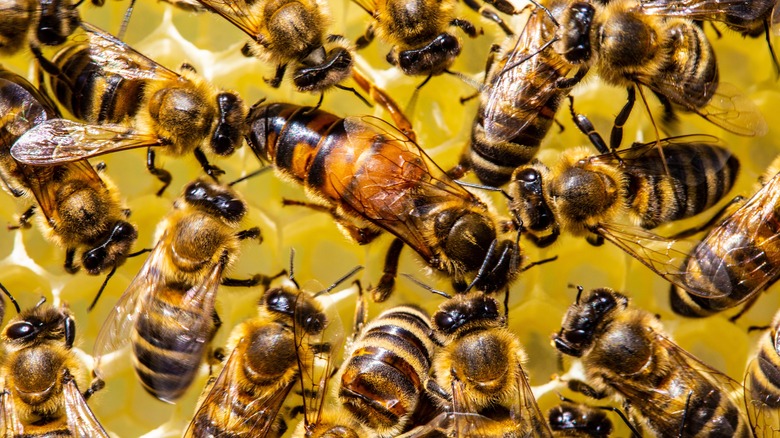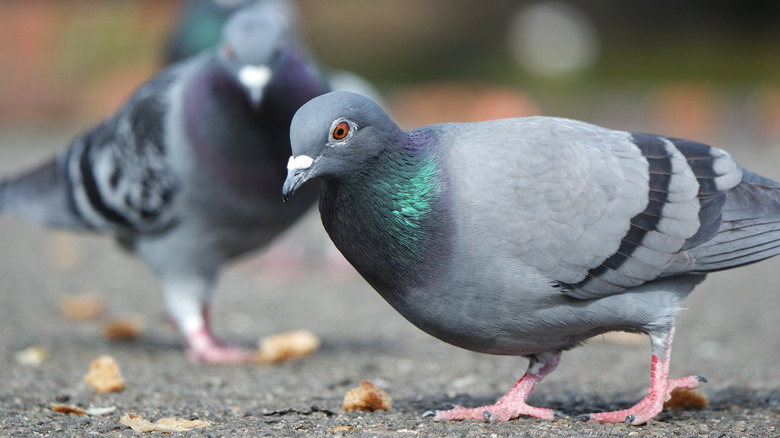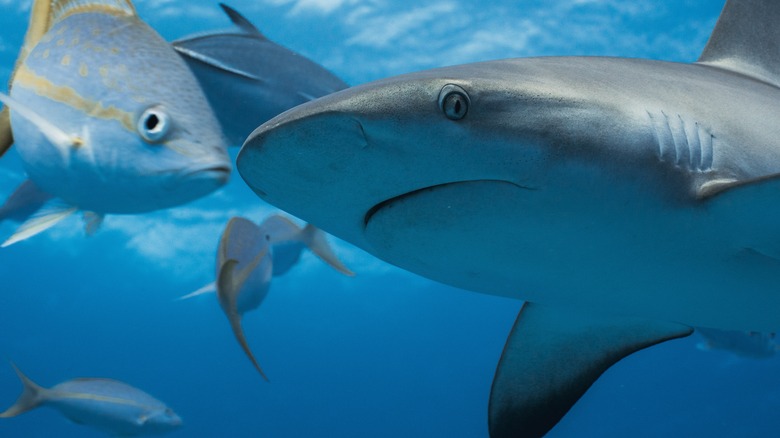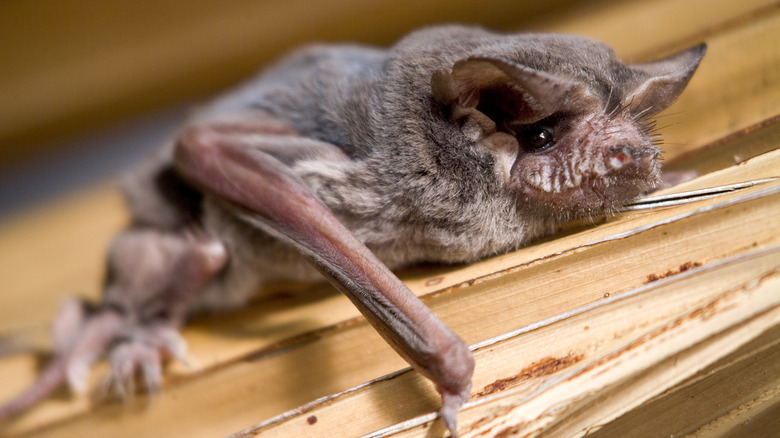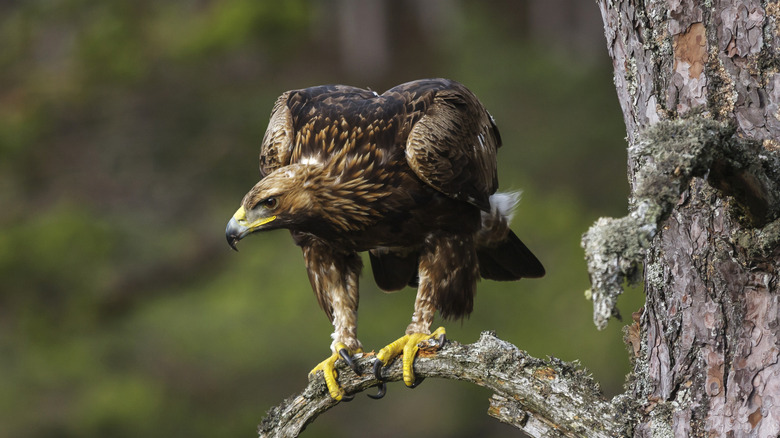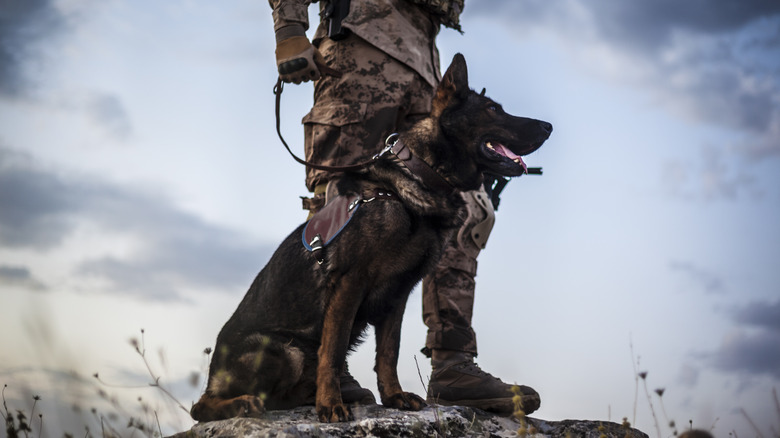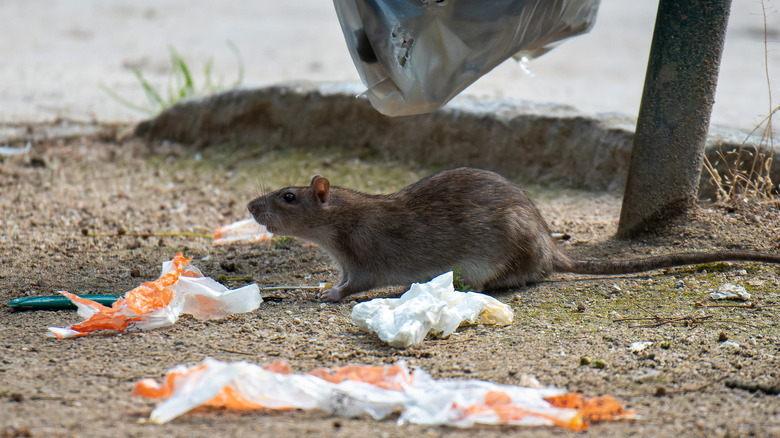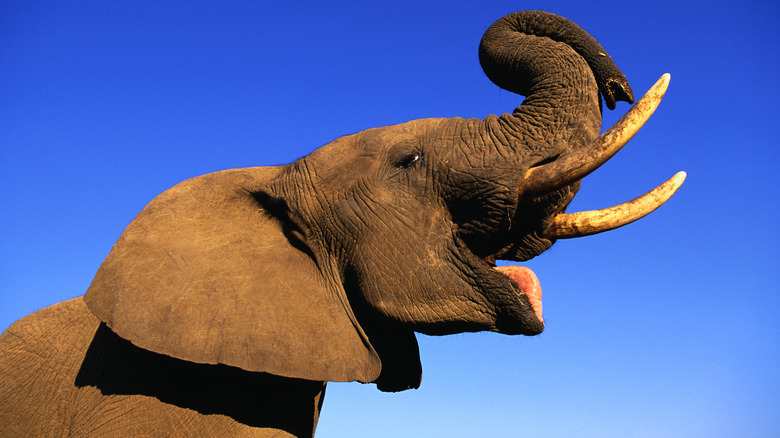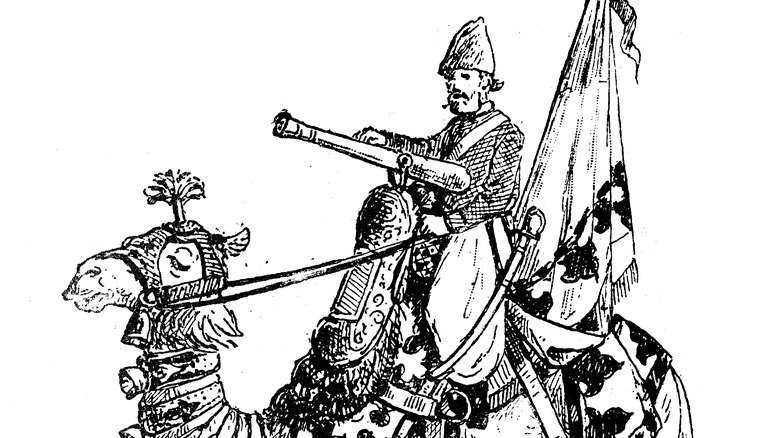10 Unexpected Military Applications For Animals
Animals have been conscripted into military service ever since mankind invented the concept of warfare. Many of these roles have been straightforward. Soldiers used to ride into battle on countless beasts of burden, ranging from horses to elephants. And ever since armies started laying mines and improvised explosive devices (IEDs), dogs and their noses have been indispensable. However, these are far from the only examples.
History is full of instances where military minds applied countless animal species to the machine of war, or at the very least, implemented them in military-adjacent purposes. For instance, during World War II, some dogs were deployed onto battlefields by tossing them out of airplanes while strapped to parachutes. Plus, the U.S. military has experimented with mosquitoes to better understand how they spread disease – although if you listen to Russian propaganda, you've probably heard claims that the U.S. army infected invading forces with bird fly by weaponizing mosquitoes. To be fair, those are in the minority, and you're more likely to find a bomb-sniffing canine than a paratrooper pooch, but they still demonstrate how far humans can think outside the box, especially when it comes to warfare and public safety.
Here are the strangest ways we've tried to use animals for military service — and why you don't see some of these ideas implemented more often.
Project Pigeon
Communication is often the key to victory, especially during war. Before the invention of radios and the internet, soldiers coordinated by sending physical messages via courier. One of the most reliable messengers was the humble homing pigeon, thanks to its unerring concentration and sense of direction, which made some people consider what other jobs pigeons could be used for.
During World War II, psychologist B.F. Skinner — the inventor of the Skinner Box — drew up the plans for what was known as Project Pigeon. He used everything he learned about Operant Conditioning (using rewards and punishment to modify behavior) to train pigeons to steer missiles towards targets by pecking at controls. The final design called for three pigeons to be placed in a cockpit at the front of the missile, where their training and tendency to incessantly peck at things would take over.
The first part of Skinner's plan went off without a hitch. All of his pigeons took to their training and passed their tests flawlessly. However, he wasn't able to win over the U.S. Army's top brass. Skinner had to wade through several rejections — and a partnership with General Mills — before he received a $25,000 grant to develop his pigeon-piloted missiles. But by then, it was too late. Project Pigeon never came to fruition because the Army was more interested in weapons with "immediate promise of combat application." In layman's terms, the army prioritized the Atom Bomb over Project Pigeon.
Acoustic Kitty
Even when an organization isn't part of a military, its projects can dictate military operations. For instance, intelligence-gathering agencies spy on enemies, and the information their agents collect is forwarded to their nation's army. However, while spies spend years training how to avoid being detected, often the best place to hide is in plain sight.
During the Cold War, the United States and the Soviet Union kept tabs on one another since both were convinced the other would strike at any moment. Each side used spy satellites and human spies, but the CIA wanted to add another tool to its intelligence-gathering folder: spy cats. Project Acoustic Kitty was a plan to turn cats into espionage devices that could listen in on Soviet meetings. Who would ever suspect a cat sleeping in Nikita Krushchev's lap?
When the project started, nobody thought they needed to train the test cat, just surgically install a microphone in its ear and a radio transmitter in its neck. However, the test failed because nobody trained the cat. The cyborg spy kitty got too distracted to pick up info from its intended target. The animal subsequently got run over by a taxi. Even when attempts were made to train the cats, testing staff concluded felines were too unreliable and lazy to be of any use. To be honest, many people could have probably told the CIA's top brass that from the beginning.
Project Headgear
In "Austin Powers," Dr. Evil had a simple dream. He wanted to own a secret lair guarded by "sharks with frickin' laser beams attached to their heads". Well, that and rule the world, but going back to the shark idea, Dr. Evil wasn't the first person who wanted to strap weapons to shark heads.
As previously stated, the U.S. and the Soviet Union prepared for open conflict during the Cold War but never engaged in large scale battles. Part of the preparation process included inventing new and novel attack strategies, one of which was Project Headgear. The idea was to sink enemy ships using sharks since torpedoes tend to set off radar equipment and sharks, well, don't. Each shark was to be decked out in a headset that steered them via electrical impulses, and when they neared the target, the bombs strapped to the headset would go off, taking out the shark and the Soviet ship or submarine with it.
After scientists built a working prototype for the titular headgear, they tested its electrode steering system on a willing volunteer, project team leader Perry Gilbert. However, when it came time to use the product on actual sharks, Project Headgear torpedoed itself. Sharks only obeyed the electronic commands for so long before they wandered off and did their own things. While studies on sharks continue to this day, any and all plans to turn them into real-life Sharpedos are sleeping with the fishes.
Operation X-Ray
According to the Bible, specifically Judges 15:4-5, Samson tried to fight off the Philistines by strapping torches to the tails of 300 foxes (or jackals) and herding them into Philistine grain fields. Even if you assume the passage is historically accurate, this isn't the only time someone wanted to wage war by lighting animals on fire.
After Japan's attack on Pearl Harbor, many U.S. citizens tried to figure out ways to strike back. One of the strangest ideas was Project X-Ray, which was created by Pennsylvania dentist Doctor Lytle Adams. He wanted to collect Mexican free-tailed bats, outfit them with timed napalm incendiary devices, and cram them into cluster bombs, 1,000 bats per bomb. When released over Japan, the bats would have scattered and roosted in the attics of Japanese buildings, and after a set amount of time, their harnesses would have gone off, setting entire cities ablaze.
While Doctor Adams sounds like he had a few too many bats in his belfry, then-President Franklin Roosevelt accepted the proposal. However, bats proved impossible to control, not helped by the fact that they were hibernating during the project. During tests, most bats either flew away or failed to wake up. In one disastrous case, some bats escaped captivity with their napalm knapsacks still active and accidentally burned down an auxiliary airfield in Carlsbad, New Mexico. However, Project X-Ray wasn't truly killed until another group of scientists demonstrated a weapon that was infinitely more destructive and controllable: the Atom Bomb.
Drone-fighting eagles
Eagles are the apex predators of the skies, and they don't take kindly to competition or invaders. However, since they have literal bird brains, eagles can't comprehend that remote-controlled drones are neither threat nor prey. Then again, eagles are pretty good at knocking drones out of the sky,.
Several police forces have dabbled with the concept of "eagle brigades." Depending on who did the training, golden eagles or white-tailed eagles were taught to catch drones that flew in restricted areas or spied on local and visiting foreign officials. Once upon a time, you could find these drone-busting birds patrolling the skies of Geneva, the Netherlands, and France. Of course, due to their size, the eagles could only tackle smaller spy drones and not weaponized Predator drones.
Despite promising results, the eagle brigades didn't last long. The Geneva branch was shut down in 2022 over safety concerns for the eagles, whereas the Netherlands-based squadron ended in 2017 because it was too expensive to maintain. Although, according to some reports, Dutch police stopped the program because the eagles didn't always do as they were told, and trainers were concerned they wouldn't perform as intended in real-world situations. Moreover, some falconers raised concerns over the eagle brigades because apparently these birds throw temper tantrums if they don't catch their intended prey, and they vent their frustrations by picking up anything else they can find. That can include the heads of nearby children. It's a good thing these eagle brigades were disbanded.
Anti-tank dogs
You might have heard stories about dogs that willingly sacrifice their lives to protect their masters, and during World War II, some soldiers used that loyalty to their advantage.
During Germany's invasion of Russia, Soviet soldiers used many tactics to defend their lands, one of which involved blowing up enemy tanks with bombs strapped to dogs. Initially, soldiers trained the animals to set off the explosions by yanking a cord. However, the canines often struggled due to the battlefield's chaos of noises and smells. In response, Soviets strapped explosives to dogs and trained them to run up to tanks. The bombs would then detonate on contact, ripping through the target and canine courier alike.
Even when the bombs were set to blow automatically, the dogs still got confused and scared on battlefields. Often, the kamikaze animal would return to their masters in the trenches. And sometimes, training methods figuratively and literally blew up in Soviet soldiers' faces. Trainers often hid food under their own tanks to teach their "disposable dogs" to crawl under enemy vehicles. However, that only habituated the animals to the smell of Russian diesel engines. Since German tanks used gasoline, the dogs got confused and sought out the more recognizable stench of diesel, even when they still carried live explosives. This tactic played out like a live (and deadly) version of a cartoon where a soldier tosses a grenade, only for a dog to fetch it as if it were a tennis ball.
Exploding rats
There's an art to sabotage. Why blow up a target when you can trick an enemy soldier into doing it for you? However, the best acts of sabotage are the ones that mess up your enemies even when the initial plan fails.
During World War II, British forces heavily relied on spies to sneak behind enemy lines and sabotage German targets. If you can think of an inconspicuous item, a secret agent probably used it to disguise an explosive. But saboteurs also used some strange and downright disgusting explosive camouflages, including dead rats. On paper, the technique was straightforward. Dead rats were stuffed full of explosives and placed in coal piles next to boilers. German workers would see the rats and toss them into the fire, unwittingly igniting the explosives. Simple yet effective.
Unfortunately, the plan backfired before it even started. German forces intercepted the one and only container full of the exploding rats before it reached its intended recipient. On the surface, that sounds like the plan was a complete failure, but that botched delivery had an unintended side effect. After German forces discovered the only crate of rat grenades, they naturally became paranoid and assumed they had only captured one shipment out of many. Thus began a nationwide and demoralizing hunt for exploding rats that didn't exist. You've got to appreciate a plan that, even in failure, preoccupies enemies with a wild goose — er, rat — chase.
Landmine-sniffing animals
As previously stated, dogs are often used to root out landmines and IEDs, but they aren't the only animals with sensitive schnozes. After all, truffle cultivators rely on pigs to locate the precious fungus. The military and other organizations have come to rely on, or at least experiment with, other animals to help locate explosives.
While dogs are the most common bomb sniffers, the environment and animals at hand have inspired different choices for search partners. For instance, U.S. soldiers stationed in South Africa trained elephants to sniff out bombs. Not only did elephants take to the training, they remembered their lessons far longer than dogs because, as they say, an elephant never forgets. And in Cambodia, African giant pouched rats are employed to seek landmines. These aren't the only examples of unorthodox organic explosive detectors. Bees are being trained to swarm around landmines, and the U.S. Navy has relied on dolphins to detect underwater mines, albeit with sonar instead of smell.
Many animals have proven themselves capable of uncovering landmines and other explosives, and scientists are constantly imagining new ways to implement living creatures. DARPA, for example, has been experimenting with caterpillars by implanting computer chips in them. When the insects undergo metamorphosis, they emerge from cocoons as cyborg butterflies that scientists can control and kit out with landmine-detecting sensors. Even though bomb seeking animals only stay in service for a few years due to their short lifespans, they are still indispensable.
Kuwaiti Field Chicken
Back when the coal industry thrived, miners brought caged canaries down into the mines. This was less to brighten moods and more of an early warning sign. If the bird dropped dead, that was a sign to get out quickly because carbon monoxide was building up. Now anything that serves as an early indicator of danger or failure is generally called a "canary in the coal mine."
Before the Gulf War, the U.S. Department of Defense didn't prioritize the risk of biological warfare, so it was unprepared when forces faced poisonous gasses. The DOD scrambled for a solution and fell back on a plan inspired by the canaries: send chickens to accompany soldiers. Since bird lungs are more delicate than human lungs, the chickens would keel over from gas long before humans were affected. The plan's name? Operation Kuwaiti Field Chicken, aka., "KFC."
Unfortunately, not only are chicken lungs more delicate than human lungs, chickens are more delicate than humans, period. The first batch of chickens were left outside overnight, and were dead when the soldiers woke up. However, this was a false positive; the chickens had died due to the cold, not gas. The DOD tried KFC again during the Iraq War, but most of these birds died before the main operation went underway. The general consensus is that the chickens pecked at sand, which clogged up their airways. While the chickens didn't serve their intended mission, they did help research the mysterious Gulf War Syndrome.
The zamburak
While horses excel at carrying soldiers over long distances at relatively high speeds, they aren't built for every kind of biome. For instance, horses don't fare well in deserts thanks to loose sand and intense heat. Camels, however, literally evolved to survive these unforgiving environments, and yet they can still carry the kinds of heavy loads that make them ideal for battlefield skirmishes.
Starting in the 17th Century, armies in the Middle East, Central and Southeast Asia, and India employed what was known as the zamburak, which was derived from "zambur," the Persian word for wasp. This weapon was a swivel gun — essentially a small cannon — that attached to the saddle of a camel, which made the zamburak an early example of mobile gun/artillery emplacements. Thanks to the camels, armies could field cannons in rough terrain that would prevent the transport of conventional artillery.
While the zamburak sounds like it would allow camel riders to attack while on the move, it was much more limited than one might imagine. Users couldn't fire the weapon while in motion; they had to stop and let the camel kneel in order to maintain accuracy and reduce the chances of injury. Plus, while the cannons were somewhat sizable, they were still smaller than your average cannon, which limited their destructive capabilities. Zamburaks were eventually phased out, but during the height of their use, they were a force to be reckoned with. We have the camel to thank for that.
